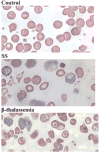Morphological and functional platelet abnormalities in Berkeley sickle cell mice
- PMID: 18374611
- PMCID: PMC2692374
- DOI: 10.1016/j.bcmd.2008.01.008
Morphological and functional platelet abnormalities in Berkeley sickle cell mice
Abstract
Berkeley sickle cell mice are used as animal models of human sickle cell disease but there are no reports of platelet studies in this model. Since humans with sickle cell disease have platelet abnormalities, we studied platelet morphology and function in Berkeley mice (SS). We observed elevated mean platelet forward angle light scatter (FSC) values (an indirect measure of platelet volume) in SS compared to wild type (WT) (37+/-3.2 vs. 27+/-1.4, mean+/-SD; p<0.001), in association with moderate thrombocytopenia (505+/-49 x 10(3)/microl vs. 1151+/-162 x 10(3)/microl; p<0.001). Despite having marked splenomegaly, SS mice had elevated levels of Howell-Jolly bodies and "pocked" erythrocytes (p<0.001 for both) suggesting splenic dysfunction. SS mice also had elevated numbers of thiazole orange positive platelets (5+/-1% vs. 1+/-1%; p<0.001), normal to low plasma thrombopoietin levels, normal plasma glycocalicin levels, normal levels of platelet recovery, and near normal platelet life spans. Platelets from SS mice bound more fibrinogen and antibody to P-selectin following activation with a threshold concentration of a protease activated receptor (PAR)-4 peptide compared to WT mice. Enlarged platelets are associated with a predisposition to arterial thrombosis in humans and some humans with SCD have been reported to have large platelets. Thus, additional studies are needed to assess whether large platelets contribute either to pulmonary hypertension or the large vessel arterial occlusion that produces stroke in some children with sickle cell disease.
Figures


References
-
- Paszty C, et al. Transgenic knockout mice with exclusively human sickle hemoglobin and sickle cell disease. Science. 1997;278:876–878. - PubMed
-
- Pritchard KA, Jr, et al. Hypoxia-induced acute lung injury in murine models of sickle cell disease. Am J Physiol Lung Cell Mol Physiol. 2004;286:L705–L714. - PubMed
-
- Belcher JD, et al. Transgenic sickle mice have vascular inflammation. Blood. 2003;101:3953–3959. - PubMed
Publication types
MeSH terms
Substances
Grants and funding
LinkOut - more resources
Full Text Sources
Medical

